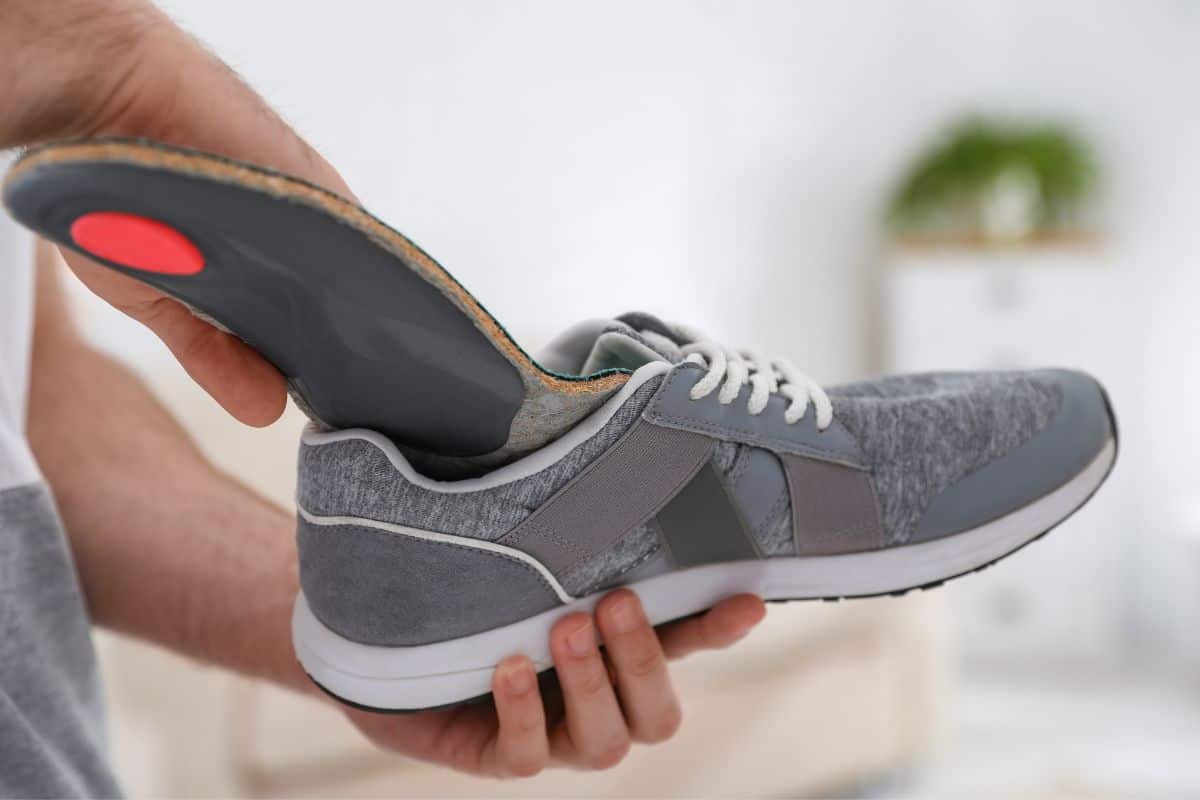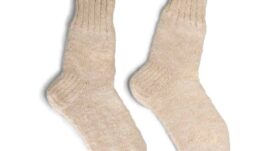This post may contain affiliate links. Please read our disclosure.
Diabetic neuropathy is a painful condition that occurs when diabetes damages the nerves. This can happen to different areas in the body, like the feet, muscles, and organs.
It can be hard to deal with this chronic pain, but there are remedies you can try to relieve the symptoms.
Diabetic neuropathy insoles may be a good solution.

Neuropathy insoles are shoe inserts designed to relieve neuropathy-related foot pain.
They can be very useful if you have a pair of favorite shoes or aren’t able to purchase neuropathy shoes.
There are many diabetic neuropathy insoles available on the market, so it can be hard to sort through all of them and select one for your needs.
To solve this issue, we’ve researched a variety of these insoles and included the best ones in our list below.
You’ll also find a buying guide with information about neuropathy shoe inserts and what to look for when purchasing a pair, as well as answers to some common questions about diabetic neuropathy insoles.
Best Diabetic Neuropathy Insoles
Orthofeet Best Arch Support Shoe Insert
Orthofeet is a brand that’s often recommended by podiatrists.
These insoles are designed to relieve plantar fasciitis symptoms, but they also work very well at soothing neuropathy-related pain.
The inserts are made with flatter foot arches in mind, as they prevent the feet from rolling inwards, relieving pain in the toes and balls of the feet.
They have a foam construction that adapts to the form of your feet, giving you a customized fit.
The foam is also moisture wicking which prevents odors from building up, while the antimicrobial top layer helps avoid fungal growth later on.
The majority of the insole is made from a supportive foam, but the heel is made from a cushioning gel.
This simultaneously absorbs shocks and soothes pain in the heel and bottom of the feet.
The inserts are also available in half sizes and three width options up to Extra Wide, so you won’t need to cut these down to size.
- Cushioning gel heel: Soothes sore heels and absorbs impact to prevent pain
- Anti-microbial upper layer: Prevents bacteria and fungal growth
- Corrective arch support: Assists flat arches to prevent overpronation, relieving inner foot pain
- Arch support may be too low for anyone with higher arches.
Protalus T100 Thin Series Premium Shoe Inserts
A lot of neuropathy insoles have a rigid heel cup, designed to stabilize and support the foot.
These shoe insoles from Protalus are different, as they swap the heel cup for their patented Tri-Planar system.
Removing the cup means the feet can move naturally, while the Tri-Planar technology supports the ankle and heel to prevent unsafe movement.
They also have anti-slip areas to prevent the insoles from moving around in the shoe, improving comfort as a result.
The insoles are thin but still have adequate cushioning to absorb shocks and impact, so your feet land softly as you move during your day.
The insoles are full-length, extending their stabilizing qualities throughout the whole foot.
This improves fatigue so you remain comfortable, even when standing for long periods.
Other than men’s and women’s sizes, the insoles are available in youth sizes too, so younger people with smaller feet can feel the benefits of these insoles.
- Thinner insole: Won’t take up too much room in the shoes
- Tri-Planar support: Stabilizes and supports feet without restricting natural movement
- Available in youth sizing: Suitable for younger people with smaller feet
- People with severe neuropathy pain may need more cushioning than these insoles deliver.
Spenco Medics Diabetics Plus Full Length Arch Support Insole
These insoles have been made with Spenco’s patented memory foam. This construction is very comfortable and delivers amazing cushioning.
The foam adapts to the shape of your feet well, providing a very supportive fit.
The impact zones, like the heel and forefoot, are also well cushioned to defend against painful shocks.
The top layer of the insoles is made from a material that reduces friction, lowering the risk of blisters and sores as a result.
The inserts are available in both women's and men's options in a range of sizes.
This is a great insole choice for anyone with delicate foot skin, as well as those experiencing painful diabetic neuropathy symptoms.
- Deeper heel cup: Fully surrounds the heel for more support
- Spenco memory foam: Adapts to the shape of your feet
- Friction-reducing upper layer: Lowers the risk of sores and blisters
- Memory foam construction isn’t suitable for machine washing.
New Balance Casual Flex Orthotic Cushioning Shoe Inserts
You may have tried New Balance sneakers in the past, but what about their insoles?
These Casual Flex insoles are molded by Superfeet, an American company known for its orthopedic inserts.
These inserts have cushioned, strong heels that defend against shocks and strikes, including two dense foam layers that ease pressure on the feet.
Their moisture-wicking material prevents odors and fungus from forming, keeping the feet healthy and dry as a result.
The insoles also have a flexible arch that suits the natural movement of the feet.
This is great for anyone who likes a resilient, bouncy feel to their shoes, as well as those that need light support.
These inserts are also very soft to the touch, which is good for delicate skin and those prone to blisters.
They are available in women’s sizes 4.5 - 12 and men’s sizes 5.5 to 17.
- Flexible arches: Suits natural movement of the feet
- Soft material: Suitable for delicate skin
- Strengthened heel cup: Protects against painful impacts
- People with wider feet may find that the flexible insole can take up space in the center foot.
Dr. Scholl s Massaging Gel Advanced Insoles
Dr. Scholl is known for their wide range of insoles.
The brand has inserts to relieve heel discomfort, plantar fasciitis, and sore feet, as well as ones that aid neuropathy symptoms.
These gel insoles deliver a pleasant massaging effect, designed to soothe and relieve sore and tired feet.
This will help you remain on your feet throughout the day, which is great for anyone who works away from a desk.
The insoles have several gel layers which take in the brunt of shocks, reducing the amount of pain felt by the feet.
The gel waves are soft and resilient, giving a bouncy feel that helps you feel more invigorated while you move.
- Gel wave layers: Massage the feet for additional comfort
- Absorbs shocks and impact: Takes in the brunt of shocks to prevent foot pain
- Bouncy feel: Energizes and invigorates the legs to improve fatigue
- Thinner sole may not be as supportive for those that require more support.
Diabetic neuropathy insole buying guide
Here is some information about the things to keep in mind when shopping for diabetic neuropathy insoles.
Diabetic neuropathy insoles: the basics
Insoles are detachable footpads which you can add or remove from your shoes. These can fit inside different types of shoes like boots, sandals, or sneakers.
Mass-produced shoes typically come with bare-bones insoles, which don’t support your feet very well.
Swapping these for inserts created by foot specialists can have several benefits, like aiding plantar fasciitis, supporting flat arches, relieving foot pain, and improving overall comfort.
More advanced benefits include improving posture, range of motion, and amending athletic performance.
Insoles designed to relieve neuropathy and diabetes insoles are equipped with several features that help prevent additional foot problems. Examples include arch support, cushioned areas, anti-blister and friction materials, shock absorbency, and pressure-relieving characteristics.
Do people with diabetes always require neuropathy insoles?
Diabetic shoe inserts are not a necessity for everyone living with diabetes.
If you are controlling your diabetes well and don’t have any foot issues, you may not need any special equipment, other than protective socks and well-made shoes.
Despite this, it’s important to keep in mind that people living with diabetes are more at risk of experiencing serious foot problems, compared to the rest of the population.
Here are some reasons why you may find neuropathy insoles useful:
Relieving neuropathy-related foot pain
Diabetes neuropathy insoles have been shown to relieve intense foot pain related to neuropathy signs, like tingling, sharp pain, burning sensations, cramping, and severe sensitivity.
They can also help avoid foot injuries later down the line, like foot ulcers in those experiencing neuropathy.
Diabetes-related plantar fasciitis
Diabetes increases the risk of experiencing plantar fasciitis, a condition that involves inflammation in the heel’s tissues.
The primary signs are sharp pains in the heel, arch, and bottom of the feet. Well-designed shoe inserts are often recommended as a treatment.
Finding the right insoles for you
It’s important to have an idea of certain features before you purchase a pair of neuropathy insoles. If you wear a pair of inserts that aren’t right for your feet, you could end up with more serious foot issues later.
You should always ask your doctor for advice on the right insoles for your condition, but here is a breakdown of the main features you should be looking out for.
Shoe insert sizing and trimming insoles
Shoe insert sizes often cover a range of shoe sizes, like ‘Women’s 7-9’, or Men’s ‘10-12’.
The majority of manufactured shoe inserts need to be trimmed to fit the shoe, which lets you cut the insole to the best fit. Anyone in between shoe sizes should go a size up and trim off the excess.
¾ and full-length insoles
People with diabetes and those experiencing neuropathy often choose full-length shoe inserts. These are designed to replace the original insole and stretch across the extent of the foot.
¾ length shoe inserts aren’t as long, as they reach from the balls of the feet to the heels.
These are designed to go on top of the present insoles. Individuals with bunions or hammertoes tend to favor ¾ insoles, though you may prefer these if you find your shoes narrower around the toes.
Low-volume and high-volume shoe inserts
The total room an insert needs within your shoes is known as the insole volume. High-volume inserts will need more room and deliver more support compared to low-volume insoles.
People living with neuropathy need to choose non-restricting shoes. Tight footwear can squeeze the legs and prevent appropriate blood circulation.
The best insole volume for you will vary based on the shoes you’ll be using them in. If you have wider shoes, high-volume inserts will provide more support and cushioning.
On the other hand, people with regular-width footwear may prefer more space and less padding. The low and medium-volume inserts will be better in this case.
Different foot arches
Feet tend to have one of three types of arches, low, high, or neutral. It’s important to know which type of arch you have, as a lot of insoles are made to support one type of arch.
If you have high arches, wearing insoles to cushion low arches, and vice versa, can lead to foot pain and more problems later on.
You can determine what type of arch you have using the water test. Simply dip one of your feet into water, then step onto a sheet of cardboard. Examine the remaining water print.
If your footprint looks like a whole foot, you have flat arches. If you don’t see a lot of your footprint, you have high ones. If the center part of the arch is halfway filled, you may have a normal arch.
If you’re unsure, you can compare the print to a foot arch chart to be certain.
Arch support
All insoles, including those made for diabetes, have four footbed options. Ones with a stiffer footbed will deliver the most arch support.
These can be hard to get used to, so it’s best to get a podiatrist’s recommendation before trying these.
Insoles with a semi-stiff footbed will also deliver adequate arch support, but they will also offer a little flexibility. These are much easier to adapt to, so they will suit most individuals.
The other two insoles have either cushioned arches or no arch support at all. These will suit people who aren’t experiencing arch discomfort or plantar fasciitis.
People with arch pain should normally choose semi-stiff or stiff arch support insoles.
Gel or foam inserts
A lot of diabetic inserts are created with gel or foam. Gel is better for absorbing shocks, while foam cushions and relieves pressure well.
Memory foam inserts adapt to the unique shape of your feet, but gel ones have a nice massaging effect. Gel insoles can also be machine washed under cold temperatures and a lot of them are anti-bacterial.
It’s always advised to clean or replace your shoe insoles regularly, especially if you live with diabetes, as this prevents fungus and bacteria from forming.
Frequently asked questions
How long do shoe inserts last for?
The majority of mass-produced shoe insoles will need to be replaced every six months unless you purchase ones suitable for machine washing. However, custom orthotics may last as long as three years with proper care.
Signs that your insoles need changing are damage, bad smells, and changes to the arches and construction.
Can diabetic foot damage be reversed?
Unfortunately, the human body cannot repair any impaired nerve tissues, so diabetic neuropathy cannot be cured. Despite this, the symptoms can be managed with the right shoes and insoles.
You should also focus on preventing more damage in the future by managing your diabetes, which involves making important lifestyle changes.
Other products for diabetic neuropathy
Foot massagers can also help with pain relief by improving blood flow and circulation. You can read our guide to the best foot massagers for people with diabetes to learn more.
Topical neuropathy creams can be applied to the feet to deliver quick and effective pain relief. These creams are generally affordable, readily available, and painless to apply.
We have a review of the best diabetic neuropathy creams that explain what to look for.
Finally, a good pair of neuropathy socks can be extremely helpful in both preventing neuropathy and alleviating the pain and discomfort if you have neuropathy.









PS Doff
“Unfortunately, the human body cannot repair any impaired nerve tissues,”
This is not true. If caught in the early stages and the cause of the diabetic neuropathy is addressed by improved blood sugar control, nerves can repair themselves.
It’s important for persons with diabetes and their providers to be aware that diabetes is not the only cause of neuropathy. Perceptual bias effects patients and doctors, causing them to assume something is what it isn’t.
Bilateral symmetrical (bilateral) lower extremity neuropathy can be induced by mechanical damage and by dietary deficiency. It’s one of the symptoms of vitamin B deficiencies. Chronic B1 deficiency is beri-beri, which is highly reversible. Person with long term diabetes can have much higher requirements for some vitamins ta the RDA due to impaired metabolism. A B vitamin deficiency blood test (like many others) requires a supplement-free diet for a minimum period of 24 hours to be accurate.
So it’s important to get neuropathy diagnosed by an expert, not a PCP who may assume itlos diabetic neuropathy. .